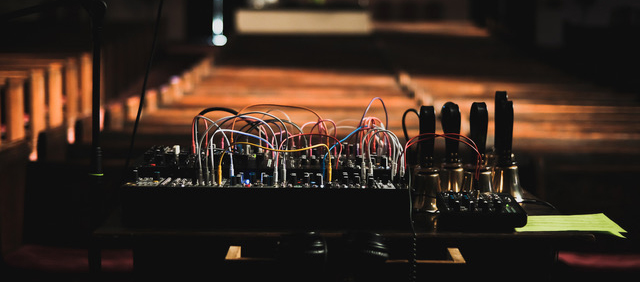First Baptist Church of Pasadena, Calif., is succeeding by doing everything wrong.
Wrong, at least, by conventional standards of what leads to church growth and health today.
The church has no social media presence, intentionally. Video of Sunday morning worship is not livestreamed and wasn’t even during the pandemic. In-person relationships are prioritized over remote connections even in a city where people drive long distances to work and social events. Sunday morning worship includes a traditional choir and pipe organ as well as sound samples of Scripture reading manipulated to be heard in new ways, along with drums and a band.
What’s happening at First Baptist Church should not work, but it does.
Undergirding this unconventional success story is generosity, according to Pastor John Jay Alvaro. “The deeper story is really the generosity of the people present. A spirit of gratitude is our main identity as a church.”
The congregation doesn’t strive to be a megachurch; it values authentic community above all. And that’s just what people seem to yearn for amid the hustle and bustle of Los Angeles.

Exterior of First Baptist Church of Pasadena, Calif.
Fittingly, Pasadena developed in the early 20th century as a resort, a place to get away from the city and stay in bungalows. But as the metropolitan Los Angeles area grew rapidly, city life encroached upon the resort community and its population boomed. Then the Tournament of Roses Parade made it famous and the Jet Propulsion Laboratory ushered in a high-tech influence.
In that context, First Baptist Church was born, rapidly growing and building a classical California-style Romanesque building in 1925. That historic sanctuary and a later educational building still stand as a prominent presence in Pasadena’s Old Town district.
In the mid-20th century, the church gathered more than a thousand worshipers every Sunday. But as Americans began to leave behind traditional religious worship — a trend highly notable in California before the South — the beautiful wooden pews at First Baptist Church became less and less populated.
Southern California became an early symbol of America’s splintering religious and cultural identities — with an increasingly secular culture spawning ever-more-conservative evangelical churches fighting against the tide and more mainline Protestant churches doing their best to hang on. There was little middle ground to be found for churches; those that succeeded were either very conservative or very liberal, very contemporary or very liturgical.
Today, First Baptist seeks to demonstrate a totally different approach that defies these labels. That’s a task well suited for Alvaro, who grew up in a Southern Baptist home, then went to Duke Divinity School after exploring his artistic side as an illustrator and musician.
All those influences come together in his leadership at the historic Pasadena church where today he’s often working a modular synth as part of his sermon, replaying and reshaping the sounds heard spoken or sung in the room.
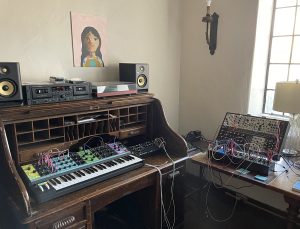
The digital setup in Pastor John Jay Alvaro’s church office.
His office, located just off the stained-glass sanctuary, features a grand piano, computer equipment, analog synths and a cassette deck for sampling. There, he’s exploring 50 years of recordings of worship services at the church, picking out sound samples for a new day. He’s also collaborating with a colleague across the country — Pastor Scott Dickison of First Baptist Church of Christ in Macon, Ga. — to set to music Dickison’s poems.
The two friends met though the pastoral residency program at Wilshire Baptist Church in Dallas, where they overlapped one year. Both now serve historic tall-steeple churches, but in different contexts and different ways.
California is a natural seedbed for Alvaro’s innate creativity and desire to explore new things. Amid that innovation, however, there are some strict limits. Alvaro has led the church to focus on the vital above the viral. He not only shuns social media, he disdains it. He wants to shepherd a congregation of people who know each other in real life first and foremost.

Stained glass and plaster work inside the chapel.
One of the ways that relational approach has paid off is that the church has become fully inclusive of all Christians regardless of sexual orientation or gender identity — without ever taking a congregational vote. It just happened by common consent.
Although the congregation was naturally inclined to be welcoming, “they didn’t know what full inclusion could look like, or why making that value explicit mattered,” Alvaro said. And then a same-sex couple with young children joined the church — and everyone knew how to embrace them and welcome them.
That became especially poignant soon after, when one of the men became terminally ill.
“Our people knew how to enact love in concrete ways: making food, caring for the kids, sharing in the grief and loss,” Alvaro said. And in that ministry, both the family and the congregation were transformed.
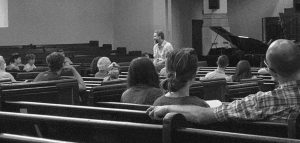
Pastor John Jay Alvaro preaches from the pew normally occupied by a beloved member of the church who had just died.
This summer, after the church member died, Alvaro sat in that man’s normal pew one Sunday and preached part of his sermon from there. He wanted to embody the message he was speaking.
While that kind of practice might be unusual for most churches, it’s par for the course at First Baptist Church, where not only the pulpit has been removed but the preacher is likely to be found anywhere in the room as he speaks. Worship at First Baptist Church is geared toward challenging the senses as well as the spirit.
This kind of experiential worship doesn’t translate well to video or livestreaming, which is one reason the church employs a simpler technology for those who cannot attend in person. Every week, audio elements are uploaded to the website for use at home in a “Liturgy for wherever you are.” Folks at home also can listen to an audio livestream later in the week.
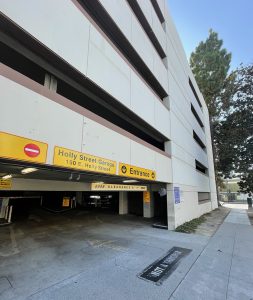
Entrance to the parking garage at First Baptist Church of Pasadena, Calif.
This simple technology served the church well during the early days of the pandemic when, unlike nearly every other church in America, First Baptist didn’t start livestreaming video. Instead, audio of various worship elements was posted to the website, along with a guide for at-home worship. As soon as it was viable, the congregation started gathering in its adjacent parking garage, where some people brought camp chairs to sit distanced from others while some people sat in their cars and listened via an FM-band radio broadcast. This allowed the church to gather without being too close indoors.
That multistory parking garage plays a pivotal role in the church’s story in another way. Several decades ago, church leaders worked out a deal with the city to lease the site for a city-owned parking garage. For years, the church has received a steady flow of income from that deal.
Next year, the 50-year contract with the city expires. This gives First Baptist an opportunity to explore how the parking structure will serve the church and community for the next 50 years, Alvaro said. “They don’t teach pastors how to negotiate with municipal authorities in seminary, but First Baptist has the same gift that all church’s possess: a community with unique skills willing to serve and guide a complex institution like the church.”
Another key income stream is derived from renting the church property for filming of television shows and movies. Even if you’ve never been to the church, you’ve likely seen it in shows staged as an Air Force office or a haunted school or the site for a spelling bee.

The gym inside First Baptist Church where community leagues practice and play every week,
Together, the filming rentals, parking garage income and rental of space to other nonprofits accounts for about one-third of the church’s annual income.
The church takes a creative approach to space rentals for other nonprofits as well. The massive building includes far more space and many more classrooms than the church needs today, so some have become studios for artists or work spaces for other nonprofits. These tenants pay rent, but part of that rent may come in creative forms, such as a painter who currently is working on a large painting for the church as partial payment for the space he occupies.
Do not let the church’s low-tech approach to streaming fool you into thinking everything is analog. The church maintains a robust website that is intended to be the focal point for all information distribution, aided by regular email distributions. The creativity shines through on the website especially in the staff team page, where images of each staff member show up as animated GIFs, with people walking in and out of the frame as though they were characters in paintings at Hogwarts.
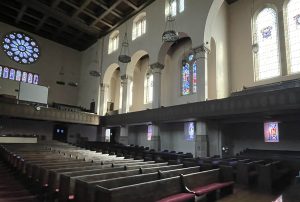
Sanctuary of First Baptist Church of Pasadena, Calif.
Religious life in California doesn’t operate the way it does in the Deep South, even for a Baptist church. For that reason, Sunday mornings at First Baptist focus primarily on the 90-minute gathered worship experience. But staff leaders are experimenting now with some post-pandemic adult classes that run for a few weeks at a time. Some members also participate in home groups throughout the week.
But the base of everything is Sunday morning worship in a beautiful sanctuary full of stained glass and dark wooden pews, with a pipe organ and drum set sharing space on an ornate chancel — worship that is so communal that when the pastor preaches from the pew previously occupied by a beloved member who died prematurely, everyone knows the meaning.
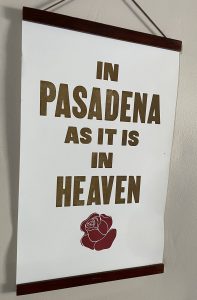 Some years ago, the church adopted a motto that is visible on letterpress-printed posters all over the building: “In Pasadena as it is in heaven.”
Some years ago, the church adopted a motto that is visible on letterpress-printed posters all over the building: “In Pasadena as it is in heaven.”
This church’s vision of heaven is real people gathered in a real space having real conversation with each other. The modern church isn’t supposed to work that way, but here, it’s working just fine.
Related articles:
An urgent appeal to my fellow ministers and other religious leaders: Suspend all public gatherings NOW | Opinion by John Jay Alvaro
At California church: Praise the Lord and honk your horn
Pastors and other church leaders: Give up social media. Not for Lent, but forever | Opinion by John Jay Alvaro

